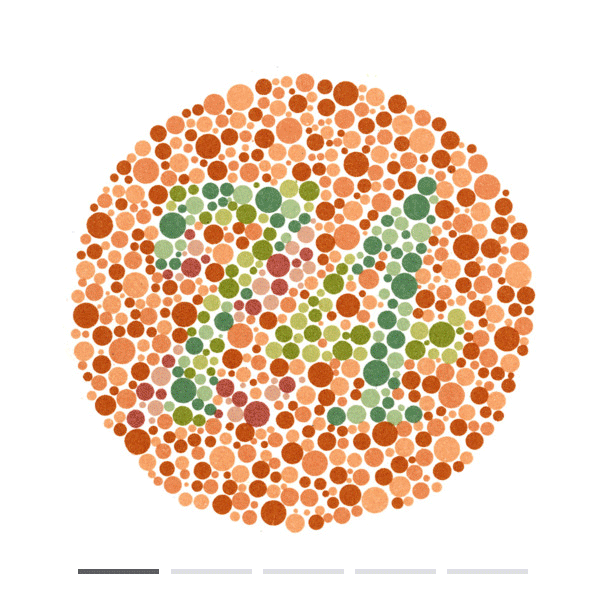After decades of watching the sun rise and set every day, it still has the power to stop us in our tracks and force us to take a moment to appreciate it. The fading light and blossoming colors are visions artists have suffered to capture since the dawn of time.
But for many, the colors in a field of flowers, the setting sun, or even the eyes of the people they love are only shades of gray.
True color blindness is incredibly rare, and most people who are diagnosed, or identify as color blind, actually experience varying degrees of “color deficiency”. Eight percent of men and 0.5 percent of women experience some form of color deficiency, with the most common form being a red/green deficiency.
We’ve all seen the test in our doctor’s offices, at school, and as a random filler in a magazine. Take a look at the following image and determine the hidden figure within each circle. Notice whether the contrast on some seems weaker than the rest. Take note of whether you struggle to find the figure in others.

If you struggle with some, don’t immediately panic. It’s possible you’re tired, or that you’ve been staring at a screen for too long today. When you’re done reading this article, take a moment to look away from your screen. Try to look as far away as you can, avoiding any screens. Giving your eyes a break every 15-20 minutes is incredibly important, especially in a world that is increasingly reliant upon screens.
The first image below demonstrates an idea of what a person with color deficiency experiences. The second image is the image a person with the Partial would experience.

As you can see, the first image isn’t actually black and white, and in many cases, a “color blind” person can identify most colors within a range of shades.
If you find yourself able to see all the colors of the rainbow, be sure you stop and stare whenever the opportunity presents itself.
If, however, you or a loved one finds yourself on the spectrum of color deficiency, stop into our office and take a pair of EnChroma glasses for a spin!
EnChroma glasses are able to counter the rod or cone malfunction to restore color reception while you wear them, often within only minutes!
Curious about other people’s experiences with EnChroma?
This family purchased a pair for their son, who was aware of colors, but had never experienced the vibrancy of grass, trees, or a blue sky. Be cautioned: his joy and gratitude may cause a sudden, unexplained leaking from the eyes. This is nothing to worry about. Here’s a tissue…
This artist had painted with colors he’d never seen, and decided to invest in a pair for himself. Initially disappointed, he invites us to experience with him as the colors slowly develop and he sees the world as he’s never seen it before!
If you are curious, or simply want to find out more about how EnChroma work, stop in to ilumin, or learn more at https://enchroma.com/
Want to get more technical?
Types of Color Blindness
As we’ve mentioned, total color blindness is rare, but it does happen. There are two possible diagnosis for total color blindness:
Cone Monochromacy – We each possess three cone cell photopigments. Red, blue, or green monochromacy occurs when two of the three fail. The reason your brain fails to recognize any color at all when only two of the three are malfunctioning is because the brain needs to contrasts and compare images to determine color and shade. If the comparison color is unavailable, you will be unable to distinguish the contrasting color. This means that while your brain could see at least one color, since it has nothing to compare it to, it simply can’t process it.
Rod monochromacy, or Achromatopsia – The rarest and most severe form of color blindness, this disorder presents itself at birth. Not only are sufferers unable to detect even a hint of color, they are also photophobic, or incredibly sensitive to light.
Blue/Yellow Deficiency
A blue/yellow deficiency is also a rare form of color blindness, but unlike other forms which tend to present predominantly in men, it tends to affect both genders equally.
Tritanomaly: Every year, candy companies like to launch prank packs of your favorite candies, usually around April Fool’s Day. You take a bite of a strawberry starburst and it’s actually lemon. Blue Raspberry is really kiwi lime. While it’s a fun mystery once a year, for people with Tritanomaly, it’s a daily occurrence.
Tritanopia: If you find yourself irritated with your partner for bringing you violet daisies when they know yellow are your favorite, or when you asked for a gray tie and ended up with mustard, it’s possibly (not likely, but possibly) this very rare blue-yellow deficiency.
Red/Green Color Deficiency
The most common form of color “blindness”, a red/green deficiency can come in varying degrees of severity. In many cases, the disorder is so mild it usually has little to no interference and can often even go undetected.
Protanomaly: Reds, oranges and yellows can take on a greenish tint, and most colors appear muted. Imagine turning the saturation down on everything you see.
Protanopia: Red appears black, oranges and greens can appear yellow, and the sufferer’s red cones are not functioning.
Deuteranomaly: The most common form of color blindness, affecting about 5% of men, this mild disorder tints greens and yellows with red, and can make it difficult to tell blues from purples and violets.
Deuteranopia: Without functioning green cone cells, reds can appear brown or yellow, and green can look pale brown or beige.







